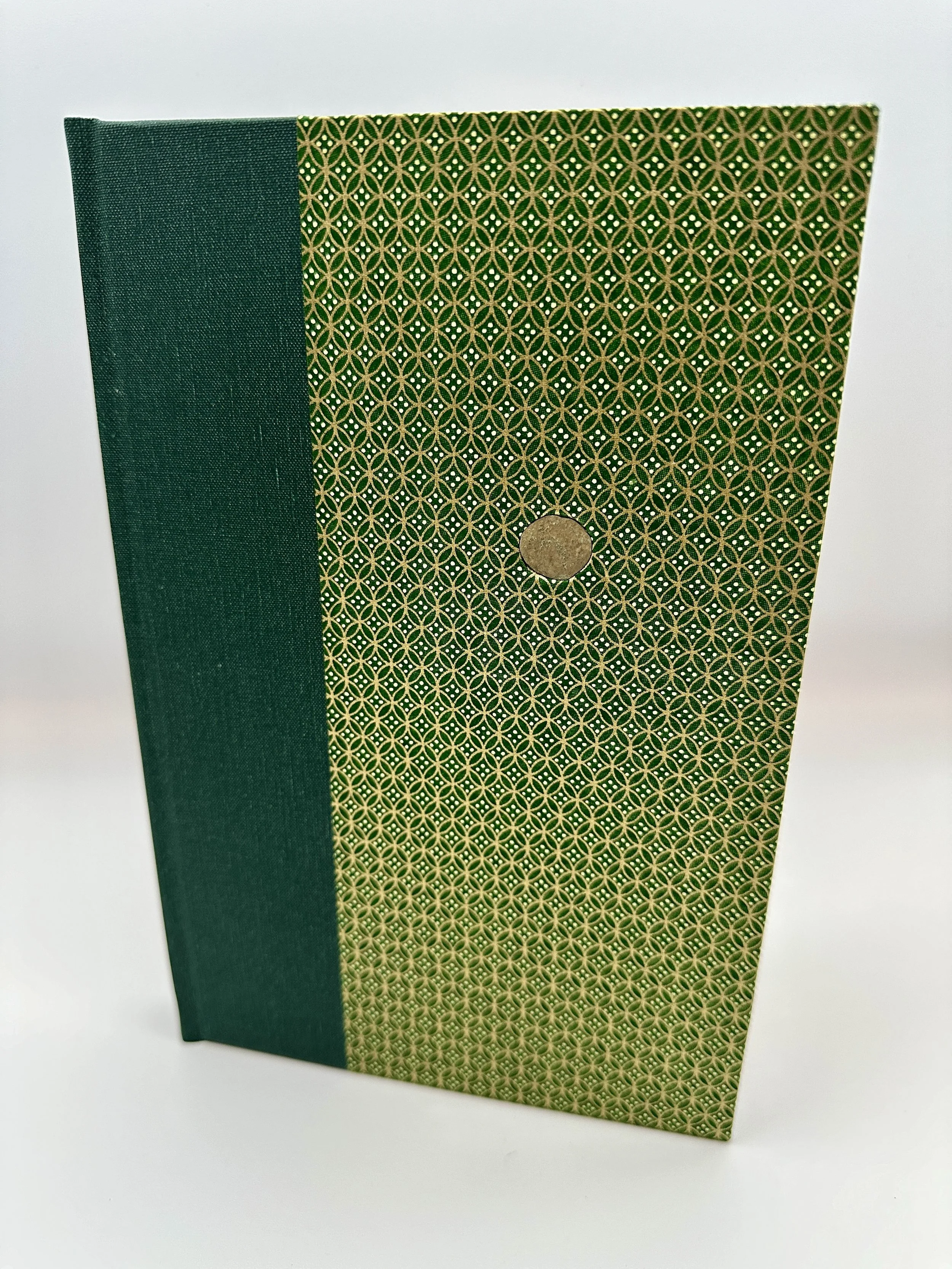 Image 1 of 8
Image 1 of 8

 Image 2 of 8
Image 2 of 8

 Image 3 of 8
Image 3 of 8

 Image 4 of 8
Image 4 of 8

 Image 5 of 8
Image 5 of 8

 Image 6 of 8
Image 6 of 8

 Image 7 of 8
Image 7 of 8

 Image 8 of 8
Image 8 of 8









Roman $
This archival, hand-sewn journal/sketchbook is made from 80 gsm Mohawk Superfine archival paper stitched with Irish linen thread in the linked pattern that was developed by the ancient Copts. This stitch allows the book to lay open easily at any page.
This book’s endbands are green and yellow cotton, and its bookmark is green satin ribbon. Its spine is covered in Buckram book cloth, and its boards are wrapped in paper that was hand silk-screened in Japan in a factory where kimono fabric is printed.
Treasure binding began with monks in the 6th Century who would encrust volumes with jewels. During the Renaissance, there was a resurgence in treasure binding. This is a contemporary revival of the treasure binding in which a lucky charm has been embedded in the cover of this book.
The talisman in this journal is an ancient Roman coin featuring a wild boar. It was found in Italy during the 20th Century. It is believed to date from the 8th Century B.C.E., the “dark ages” in Europe. This coin has lived in the pockets and pouches of many, and if to nothing else, it has brought good luck to itself in being found again.
This book is approximately 6.5 x 9” with a few more than 150 blank pages.
This archival, hand-sewn journal/sketchbook is made from 80 gsm Mohawk Superfine archival paper stitched with Irish linen thread in the linked pattern that was developed by the ancient Copts. This stitch allows the book to lay open easily at any page.
This book’s endbands are green and yellow cotton, and its bookmark is green satin ribbon. Its spine is covered in Buckram book cloth, and its boards are wrapped in paper that was hand silk-screened in Japan in a factory where kimono fabric is printed.
Treasure binding began with monks in the 6th Century who would encrust volumes with jewels. During the Renaissance, there was a resurgence in treasure binding. This is a contemporary revival of the treasure binding in which a lucky charm has been embedded in the cover of this book.
The talisman in this journal is an ancient Roman coin featuring a wild boar. It was found in Italy during the 20th Century. It is believed to date from the 8th Century B.C.E., the “dark ages” in Europe. This coin has lived in the pockets and pouches of many, and if to nothing else, it has brought good luck to itself in being found again.
This book is approximately 6.5 x 9” with a few more than 150 blank pages.
This archival, hand-sewn journal/sketchbook is made from 80 gsm Mohawk Superfine archival paper stitched with Irish linen thread in the linked pattern that was developed by the ancient Copts. This stitch allows the book to lay open easily at any page.
This book’s endbands are green and yellow cotton, and its bookmark is green satin ribbon. Its spine is covered in Buckram book cloth, and its boards are wrapped in paper that was hand silk-screened in Japan in a factory where kimono fabric is printed.
Treasure binding began with monks in the 6th Century who would encrust volumes with jewels. During the Renaissance, there was a resurgence in treasure binding. This is a contemporary revival of the treasure binding in which a lucky charm has been embedded in the cover of this book.
The talisman in this journal is an ancient Roman coin featuring a wild boar. It was found in Italy during the 20th Century. It is believed to date from the 8th Century B.C.E., the “dark ages” in Europe. This coin has lived in the pockets and pouches of many, and if to nothing else, it has brought good luck to itself in being found again.
This book is approximately 6.5 x 9” with a few more than 150 blank pages.
